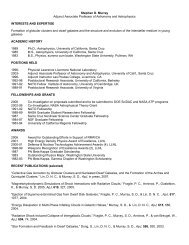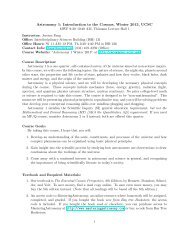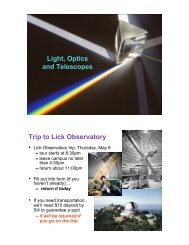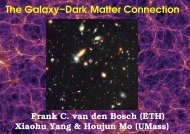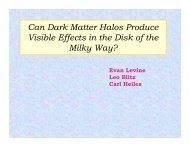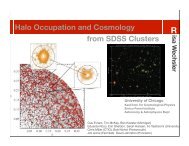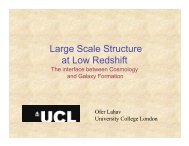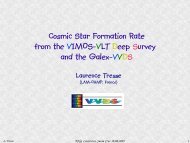Kathryn Johnston
Kathryn Johnston
Kathryn Johnston
Create successful ePaper yourself
Turn your PDF publications into a flip-book with our unique Google optimized e-Paper software.
Stellar<br />
Halos and<br />
Satellite<br />
Systems in<br />
a Lambda<br />
CDM<br />
Universe<br />
<strong>Kathryn</strong> V <strong>Johnston</strong> (Wesleyan)<br />
James S Bullock (Irvine)<br />
Andreea Font (Wesleyan)<br />
Brant Robertson (Harvard)<br />
Bullock & <strong>Johnston</strong>, 2005<br />
Robertson et al, 2005<br />
Font et al, 2005
Given:<br />
Motivation<br />
– hierarchical structure formation;<br />
– properties of Local Group dwarfs<br />
What can we say about:<br />
– stellar halos<br />
– satellite systems<br />
– substructure in stellar halos<br />
(NGC5907, Shang et al 1999)<br />
(inspired by Majewski, Spaghetti, SDSS, Ibata et al, Guhathakurta....)<br />
Modeling (and observational) problem: low<br />
luminosity and surface brightness of objects<br />
and features we’re interested in.<br />
(related studies: Brook et al; Knebe et al; Rende et al; Abadi, Navarro,<br />
Steinmetz; Diemand, Madau, Moore....)
Dark matter<br />
modeled via<br />
merger tree.<br />
100,000-particle<br />
N-body model<br />
run for each<br />
luminous satellite<br />
accreted.<br />
Masses, orbits<br />
accretion times<br />
dictated by<br />
cosmology<br />
Methods - Our Approach<br />
time<br />
Light matter<br />
painted on<br />
subsequently<br />
to match<br />
properties of<br />
Local Group<br />
dwarfs today....
Methods - Sanity Checks<br />
- 11 satellites of Milky Way (similar number for M31)<br />
=> how many baryons to assign to each dark satellite (via<br />
“squelching” of low end of luminosity function due to re-ionization -<br />
see Bullock, Kravtsov & Weinberg, 2000)<br />
- field dwarfs have significant gas content (e.g. Grebel et al , 2003)<br />
=> how fast to turn baryons into stars (i.e. long timescale for star<br />
formation, consistent with earlier talks...)<br />
- field dwarfs follow well defined correlations in luminosity and core<br />
radius (e.g. Mateo, 1998)<br />
=> how to embed stars within halos<br />
In addition, the model fits:<br />
(i) stellar halo luminosity;<br />
(ii) Hernquist profile;<br />
(iii) distribution of satellite structural properties.
Model for Formation of a Halo<br />
Color bar 34-24 mag/arcsec 2<br />
Luminosity-weighted<br />
dark matter<br />
Embedded King models
Model for Formation of a Halo<br />
Color bar 38-23 mag/arcsec^2, boxsize 300kpc<br />
(cf: Pieter van Dokkum’s images)
Features<br />
brighter than<br />
30 mag/<br />
arcsec^2<br />
common
Brightest<br />
features<br />
generally<br />
correspond<br />
to rare,<br />
latedisruption<br />
events
Model for Formation of a Halo<br />
- Halo built inside<br />
out<br />
- Majority of halo<br />
from few most<br />
massive events<br />
- Surviving<br />
satellites accreted<br />
recently<br />
- Mostly smaller<br />
than those that<br />
built the halo
Abundance Patterns in Satellites vs<br />
Venn et al (2004)<br />
Halo<br />
The challenge for<br />
Lambda CDM:<br />
satellites look<br />
chemically different<br />
from the halo....<br />
(e.g. Unnavane,<br />
Wyse & Gilmore,<br />
1996)
Abundance Patterns in Satellites vs<br />
Halo<br />
You cannot get ....<br />
from....<br />
...*!@!!!!
Abundance Patterns in Satellites vs<br />
Created in SNII<br />
< 100 Myr timescale<br />
Created in SNII<br />
and SNIa<br />
> 1 Gyr timescale<br />
Halo
Abundance Patterns in Satellites<br />
vs Halo<br />
Test our timing/mass arguments:<br />
• Brant Robertson: leaky/accreting box chemical<br />
evolution code (Robertson, Bullock, Font, <strong>Johnston</strong> &<br />
Hernquist, 2005) requiring matches to<br />
- mass-metallicity relation for dwarfs today<br />
- low alpha-element abundances of dwarfs today<br />
• Andreea Font: combine this with our results to create<br />
phase-space plus abundance space models (Font,<br />
<strong>Johnston</strong>, Bullock & Robertson, 2005).
Boxsize:<br />
300kpc<br />
38-23<br />
mag/arcsec^2<br />
-2.5 < [Fe/H]<br />
< -0.5<br />
-0.1 < [alpha/Fe]<br />
< 0.2
Abundance Patterns in Satellites<br />
vs Halo
Abundance<br />
variations<br />
within<br />
stellar halos<br />
e.g M31 -<br />
Ferguson, Ibata,<br />
Irwin, Chapman,<br />
Lewis....<br />
(see also Guhathakurta;<br />
Brown et al; Mouchine et<br />
al...)
... only stars<br />
with [alpha/<br />
Fe]
Summary<br />
The BIG picture: (i) stellar halos are built inside<br />
out from a few massive dwarfs; (ii) bulk of halo<br />
accreted much earlier than surviving satellites.<br />
Natural consequences of Lambda CDM:<br />
=> features from recent events at ~30 mag/arcsec^2<br />
common<br />
=> these represent relatively rare, late-infall events<br />
=> abundance patterns in late accretions and<br />
surviving satellites different from rest of halo<br />
=> cuts in alpha-abundance will be sensitive to<br />
different accretion times




